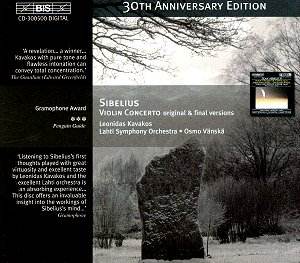The
Sibelius family has taken a very protective attitude towards the
composerís papers; unnecessarily so considering that any number
of youthful indiscretions, false starts and the like could not
detract an iota from the mighty symphonies and the best of his
other works. Only very gradually have the archives been opened
up. It had long been known that the Violin Concerto (in common
with a few other works, most notably the Fifth Symphony) was first
presented in a version very different from the final one, but
only in about 1990 was permission given for this, and only this,
recording of it. Since it is to be the only recording, it would
have been terrible if it had not been a good one. Fortunately,
the performance of the final version is of such quality as to
set our minds at rest. At the outset I wondered if there was going
to be too much portamento, but this is countered by the silvery
purity of Kavakosís tone, which soars rapturously, passionately
and meditatively as required above Vänskäís dark-hued
orchestra. My one small reservation is that the finale, broadly
taken, could have greater impetus. Oddly enough, this matters
less in the performance of the first version where the major-key
material which Sibelius later expunged in itself lessens the impetus
of the music. All the same, this is a version to rank with the
best.
It
is a sobering thought that a professor of composition, if asked
to comment on the concerto in its original form, would probably
have told Sibelius to leave the second movement as it is (changes
are minimal) and prune the third (as was done), but throw out
the first and start again. To a lesser mortal, this first movement
really does seem too much of a ragbag of ideas to stand any chance
of being put in order. It is a most disconcerting listening experience.
It begins much as we know it, but before long we are in a foreign
territory entirely, and a strange one at that. It is not only
a question of there being many episodes based on material unknown
to us (and one of the orchestral episodes seems remarkably banal);
stranger still is when themes which know where they are going
in the final version sound here to be lost or to be leading in
another direction. The glorious second subject (as we now know
it) is present but only has a minor place in the proceedings.
It is quite extraordinary to reflect that only a year later Sibelius
was to develop this into the taut piece we know. If you love Sibelius
you will need to have this for the insight it offers into his
thought processes.
The
recording is a wide-ranging one; too much so in my opinion. With
the volume at a normal level I only realised the music had started
when the violin entered, so I turned the volume up and started
again. Yet some of the brass climaxes are excessively powerful
even with the volume back down to normal and I had difficulty
in finding a setting which could be maintained without adjustment
from beginning to end. The sound in itself is magnificently truthful.
Christopher
Howell
